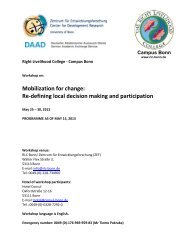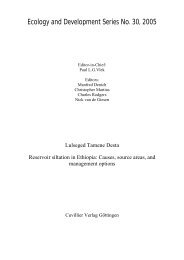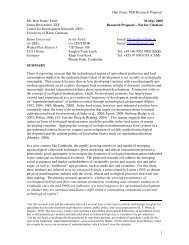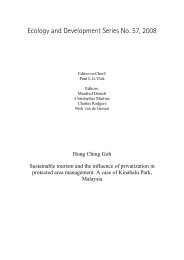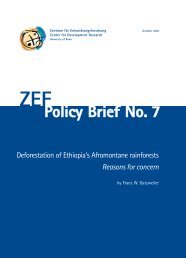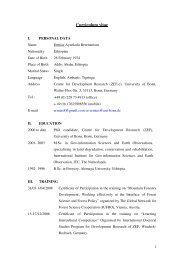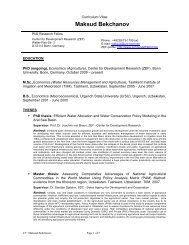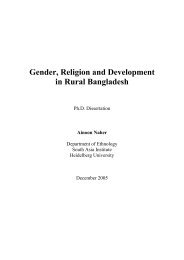ZEF Bonn
ZEF Bonn
ZEF Bonn
Create successful ePaper yourself
Turn your PDF publications into a flip-book with our unique Google optimized e-Paper software.
Table 3: Extent of soil degradation within the area affected by land degradation.<br />
Land use Total area within Area affected by Area affected by<br />
Category drylands land degradation soil degradation<br />
(million ha) (million ha) (million ha)<br />
Irrigated<br />
cropland 145 43 4<br />
Rainfed<br />
cropland 457 216 216<br />
Rangeland 4,556 3,333 757<br />
Total 5,158 3,592 1,016<br />
Data source: UNEP (1991)<br />
The preponderance of evidence collected thus far confirms that land degradation is<br />
a man-made problem. It is not a new phenomenon and has been in existence since<br />
the dawn of agriculture (Barrow, 1991 and Hillel, 1991). What is new is the intensity<br />
of degradation in recent times. For example, Rozanov et al. (1990) showed that the<br />
soils of the world lost 25.3 million tons of humus per year on average since agriculture<br />
began some 10,000 years ago. However, average humus losses were 300 million<br />
tons per year in the last 300 years and 760 million tons in the past 50 years. So<br />
they appear to accompany the growth of population, expansion of croplands,<br />
destruction of vegetation, global warming and emergence of yield-enhancing technologies.<br />
In essence, the last 50 years have been a saga of economic growth and<br />
ecological losses, both unevenly distributed. The inherently disadvantaged dryland<br />
environments have suffered relatively more ecological damage and less economic<br />
gain. Although the causes of land degradation are well-documented, it continues to<br />
spread at a rate of 6 million ha per annum (FAO/UNEP, 1984).<br />
Dregne and Chou (1992) estimate that nearly 1,860 million ha, or little more than<br />
half of the desertified area world-wide, requires rehabilitation. The cost of rehabilitation<br />
over a 20-year period was calculated to be about US$ 213 billions. If not rehabilitated,<br />
Dregne and Chou figure that the income foregone (over a 20-year period)<br />
could equal a staggering US $ 564 billions. Razanov et al. (1990) believe that the<br />
annual loss through degradation (6 million ha) is practically irreversible. The reliability<br />
of these statistics has been a subject of debate (Mainguet, 1994, and Thomas and<br />
Middleton, 1996). Although the accuracy of the numbers may be argued, the magnitude<br />
of the problem and its potentially negative impact on sustainable development<br />
is beyond question. In fact, if present trends are any indication, it is anticipated that<br />
the severity of desertification will increase as the pressure of population on land<br />
mounts, becoming all the more intense in developing countries.<br />
Statistics on disasters resulting from creeping events are difficult to come by. First of<br />
all, the consequences of such processes are coped with in many different ways. In<br />
the case of desertification, for instance, strategies are applied that reduce population<br />
pressure through permanent out-migration, migrant labour and remittances.<br />
Although often associated with personal tragedies, this uprooting of societies rarely<br />
Essay<br />
Degradation has a profound<br />
impact on sustainable development.<br />
If present trends are<br />
anything to go by, the severity<br />
of desertification will increase<br />
as the pressure on land<br />
mounts, becoming all the more<br />
intense in developing countries.<br />
21



